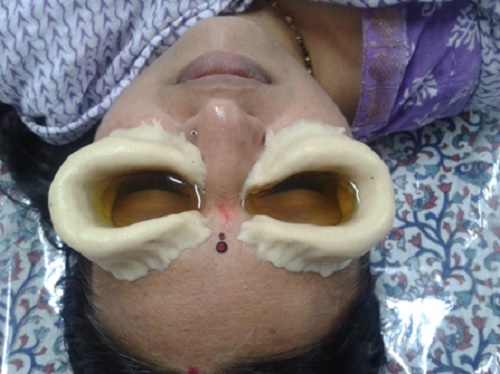Jun 30, 2025
Jun 30, 2025
Tarpana is the procedure for ‘Snehana’, trupti or soothing of eye.
In this kriykalpa of netra, a small layer of Udada (Black gram) dough is being passed around the eyes and then warmed medicated sneha (Ghruta, Tail, Wasa, Majja) are pored inside it, till the eye lashes will dip completely then the time (matras) are counted according to the disease. When tarpana kala is completed, sneha is soaked by cotton and finally dough is removed.

This procedure has been widely used in the various types of eye disorders like dry eye syndrome, ARMD (age related macular degeneration), diabetic retinopathy, etc and has been proved beneficial to prevent the progress of the disease. The role and mechanism of its working is still not clear and modern science techniques are unable to predict the mechanism.
As Aacharya Sushruta has mentioned Purush as ‘Snehomaya’ i.e. everything that exists is made up of Sneha. Twelve Prana including chakshurendriya live along with sneha. With this reference, Sneha and chakshurendriya are strongly related with each other and sneha plays an important role in constitution of eye. Sukshma guna in sneha can reach upto sukshma strotasas and perceive its subject i.e. roop grahan. Reduction in sneha leads to dryness and weakness as mentioned by Sushrutacharya.
Though, Netra is Tejomaya, its functions gets hampered due to vitiation of Alochaka pitta hence sneha is essential to prevent and cure vitiation of pitta. Netra-tarpana plays role of Rasayana by nourishing all the tissue of eye, as Charakacharya mentioned that Drudhendriya is the benefit of sneha. Ghruta has property of ‘Sanskaranuvartanam’ so it carries and enhances the properties of drugs used for ghrutapaka.
This medicated ghruta or sneha may get absorbed in tritiya chaturtha patal as they are medashrit and asthyashrit respectively because Dalhan has mentioned the time required to absorb sneha in meda dhatu is about 700 matras and tarpankal for drushtigata vyadhi is 1000 matras.
If we think about ‘Utpatti’ (development) of parts of netra, shwet and krushna parts are kapha and rakta prasadaj respectively and Drushtimandal is kapha raktaprasadaj so, the medicated sneha applied or pored over shwet and krushna bhaga can act on Drushtimandal. Also, shwet mandal is Pitruj, krushnamandal is matruj and Drushtimandal is both matruj and pitruj part. This reference also explains the role of medicated sneha pored at shukla and krushna mandal on Drushti mandal.
According to modern science, anatomically anterior cilliary veins opens into Shlem’s canal. The medicated ghruta may get absorbed through anterior cilliary vessels into Shlem’s canal and through canal; it may enter in anterior chamber then into posterior chamber and then may get absorbed into ratina.
To conclude with above explanations and references, the ancient Aacharya’s and modern science findings are same. Netratarana process can act over ratinal diseases or trutiya-chuturtha patalgat dosh dusthi.
01-Feb-2014
More by : Hema Ramachandra Kolape